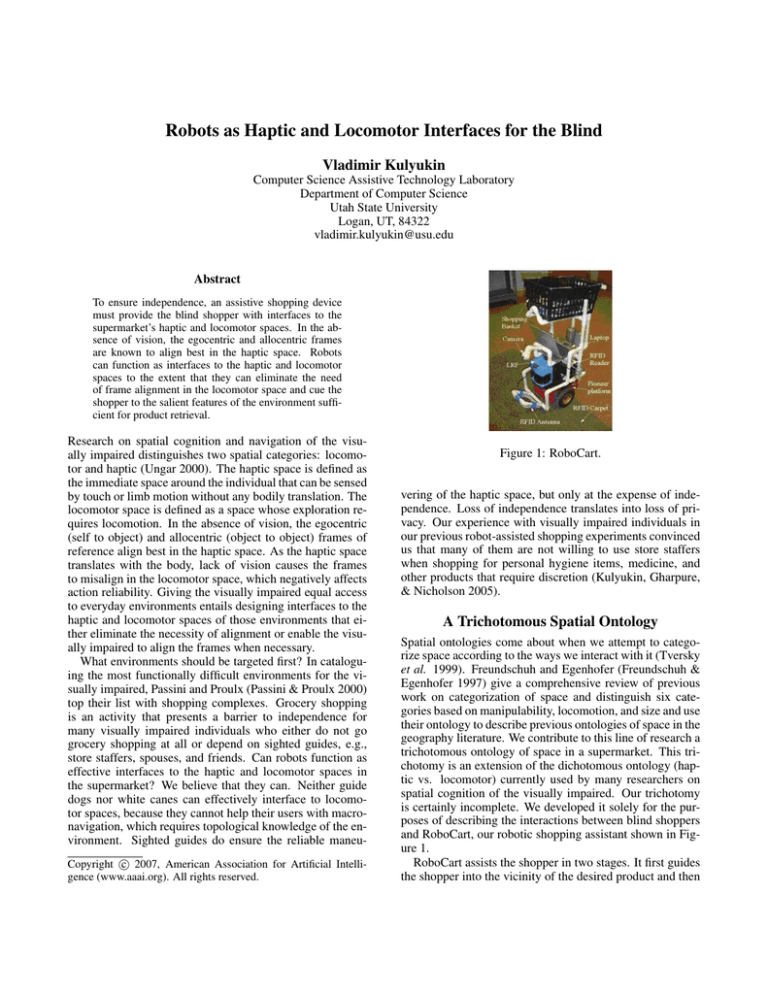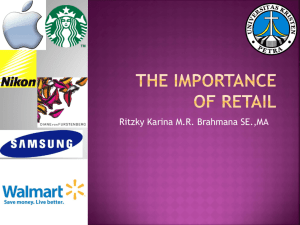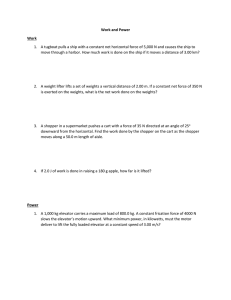
Robots as Haptic and Locomotor Interfaces for the Blind
Vladimir Kulyukin
Computer Science Assistive Technology Laboratory
Department of Computer Science
Utah State University
Logan, UT, 84322
vladimir.kulyukin@usu.edu
Abstract
To ensure independence, an assistive shopping device
must provide the blind shopper with interfaces to the
supermarket’s haptic and locomotor spaces. In the absence of vision, the egocentric and allocentric frames
are known to align best in the haptic space. Robots
can function as interfaces to the haptic and locomotor
spaces to the extent that they can eliminate the need
of frame alignment in the locomotor space and cue the
shopper to the salient features of the environment sufficient for product retrieval.
Research on spatial cognition and navigation of the visually impaired distinguishes two spatial categories: locomotor and haptic (Ungar 2000). The haptic space is defined as
the immediate space around the individual that can be sensed
by touch or limb motion without any bodily translation. The
locomotor space is defined as a space whose exploration requires locomotion. In the absence of vision, the egocentric
(self to object) and allocentric (object to object) frames of
reference align best in the haptic space. As the haptic space
translates with the body, lack of vision causes the frames
to misalign in the locomotor space, which negatively affects
action reliability. Giving the visually impaired equal access
to everyday environments entails designing interfaces to the
haptic and locomotor spaces of those environments that either eliminate the necessity of alignment or enable the visually impaired to align the frames when necessary.
What environments should be targeted first? In cataloguing the most functionally difficult environments for the visually impaired, Passini and Proulx (Passini & Proulx 2000)
top their list with shopping complexes. Grocery shopping
is an activity that presents a barrier to independence for
many visually impaired individuals who either do not go
grocery shopping at all or depend on sighted guides, e.g.,
store staffers, spouses, and friends. Can robots function as
effective interfaces to the haptic and locomotor spaces in
the supermarket? We believe that they can. Neither guide
dogs nor white canes can effectively interface to locomotor spaces, because they cannot help their users with macronavigation, which requires topological knowledge of the environment. Sighted guides do ensure the reliable maneuc 2007, American Association for Artificial IntelliCopyright gence (www.aaai.org). All rights reserved.
Figure 1: RoboCart.
vering of the haptic space, but only at the expense of independence. Loss of independence translates into loss of privacy. Our experience with visually impaired individuals in
our previous robot-assisted shopping experiments convinced
us that many of them are not willing to use store staffers
when shopping for personal hygiene items, medicine, and
other products that require discretion (Kulyukin, Gharpure,
& Nicholson 2005).
A Trichotomous Spatial Ontology
Spatial ontologies come about when we attempt to categorize space according to the ways we interact with it (Tversky
et al. 1999). Freundschuh and Egenhofer (Freundschuh &
Egenhofer 1997) give a comprehensive review of previous
work on categorization of space and distinguish six categories based on manipulability, locomotion, and size and use
their ontology to describe previous ontologies of space in the
geography literature. We contribute to this line of research a
trichotomous ontology of space in a supermarket. This trichotomy is an extension of the dichotomous ontology (haptic vs. locomotor) currently used by many researchers on
spatial cognition of the visually impaired. Our trichotomy
is certainly incomplete. We developed it solely for the purposes of describing the interactions between blind shoppers
and RoboCart, our robotic shopping assistant shown in Figure 1.
RoboCart assists the shopper in two stages. It first guides
the shopper into the vicinity of the desired product and then
instructs the shopper on how to maneuver the haptic space
within that vicinity. In the first stage, RoboCart interfaces
the shopper to the locomotor space, guiding the shopper to
the required aisle section and interacting with other shoppers by asking them to yield the way when a passage is
blocked. In the second stage, RoboCart cues the shopper to
some salient features of the environment near the haptic interface through voice instructions grounded in the shopper’s
egocentric frame of reference.
The design of RoboCart reflects this dual interface functionality insomuch as the device consists of two modules: locomotor and haptic. The locomotor module consists of a Pioneer 2DX mobile robotic base from ActivMedia, Inc. upon
which a wayfinding toolkit is fitted in a PVC pipe structure. A shopping basket is mounted upon the PCV structure, as shown in Figure 1. The PVC structure includes a
firm handle at the lower abdomen level. A 10-key numeric
keypad is attached to the handle for giving instructions to
RoboCart. Using the numeric keypad, the shopper can either
browse through a list of products or enter a product number.
Once the shopper confirms the selection, RoboCart guides
the shopper to the vicinity of the product.
The haptic module consists of a wireless omni-directional
barcode reader. The reader is ergonomically modified to
help the shopper align the reader with the shelf. After RoboCart brings the shopper in the vicinity of the product, RoboCart uses the shopper’s egocentric frame of reference to instruct the shopper through synthetic speech on how to find
the product, e.g. Honey Nut Cheerios is on the top shelf to
your right. The shopper finds the shelf and uses the barcode to scan the barcodes on that shelf. The product name
of each scanned barcode is read to the shopper. As the robot
moves, the rigid PVC handle gives the shopper haptic feedback about the robot’s maneuvers.
To describe how the visually impaired shopper interacts
with the supermarket space using RoboCart, we introduce
the category of target space. The target space is the shoppercentric subspace of the locomotor space in which the shopper perceives the target product to be. The target space is always defined with respect to a specific target product. Haptic cues in the target space act as external reference points
during the shopper’s maneuvering of the haptic space in the
target space until the haptic space contains the product.
Experiments
We formulated several research hypotheses to test how well
RoboCart functions as haptic and locomotor interface to the
supermarket.
• Hypothesis 1: If the robot is consistent overtime in how
it sets up the target space with respect to a given product and verbally orients the shopper in the target space,
the shopper’s efficiency of maneuvering the haptic space
in the target space increases with experience in the target space where experience is measured as the number of
shopping iterations.
• Hypothesis 2: The shopper’s efficiency of maneuvering
the haptic space in the target space is inversely related to
the area of the target space.
• Hypothesis 3: The shopper’s efficiency of maneuvering
the haptic space in the target space is inversely related to
the complexity of the target space.
• Hypothesis 4: In the absence of any prior knowledge of
the target space, minor differences in sensory abilities affect the target space performance.
• Hypothesis 5: The location of the product on the shelf
(top, middle, bottom levels) affects the performance.
Ten visually impaired participants from various locations
in Utah were recruited for the experiments through the Utah
Chapter of the National Federation of the Blind (NFB) in
Salt Lake City, Utah. The Utah NFB Chapter provided us
with a list of visually impaired Utah residents. Each individual on the list was first contacted by e-mail. The e-mail
briefly described RoboCart and the experiments and asked
the addressee if he or she would be interested in participating in the experiments. A brief phone interview was conducted with all those who responded positively. The inclusion criteria were: 1) the participant must be ambulatory; 2)
the participant may not have any hearing or cognitive impairments; 3) the participant must understand English; and
4) the participant must be willing to travel to Logan, Utah,
for a period of two days. Ten participants were thus selected.
Each of the selected participants was transported to Logan,
Utah, by vehicle for a period of two days and was paid a
$90 honorarium.
The procedure consisted of two stages. First, the individual was given a 30 minute introduction to RoboCart in
our laboratory. The participant was trained in using RoboCart’s keypad and used RoboCart to navigate a short route
in the office space around the laboratory. The participant
was then asked to take a technology readiness survey (Parasuraman 2000) which was used to calculate the participant’s
Technology Readiness Index (TRI). Second, the participant
was driven to Lee’s MarketPlace, a supermarket in Logan,
Utah, and asked to use RoboCart to shop for several products. Twelve products were chosen from two aisles: 4 products from bottom shelves, 4 products from middle shelves,
and 4 from top shelves. In Lee’s MarketPlace, each aisle
consists of several shelf sections. A shelf section spans 4 to 5
meters in length and consists of 5 to 8 shelves. The selected
products were divided into 4 sets. Set 1 included 3 products
on top shelves; Set 2 included 3 products on middle shelves;
Set 3 included 3 products on bottom shelves; Set 4 included
one product on a top shelf, one product on a middle shelf,
and one product on a bottom shelf. Five shopping iterations
were conducted for each product set. The following measurements were taken during each run: 1) navigation time
from location to location; 2) product retrieval time (time
interval that starts when RoboCart stops and instructs the
shopper on where the product is in the target space and ends
when the shopper puts the product into RoboCart’s basket);
3) the distance between the robot and the product; and 4)
the number of other shoppers encountered on route. We also
recorded observations regarding specific haptic cues used by
the participants to find products. Two observers accompanied the participants on every run: the first observer was
monitoring RoboCart; the second observer was making and
recording measurements and observations.
performance: 0.47, 0.29, 0.53 and 0.22, respectively.
Results
Conclusions
Given the space limitations of an extended abstract, we give
the results without graphs and tables. In testing hypothesis
1, we found that the participant’s efficiency in maneuvering
the haptic space in the target space appears to improve with
experience. In testing hypothesis 2, we found a very low correlation coefficient (Pearson’s product moment) of 0.37 between the target space area and the shopper’s performance,
which suggests that Hypothesis 2 may not hold for our sample. To test Hypothesis 3, we used the product density as the
measure of the target space complexity. The product density
was computed as the number of products per foot between
the robot and the target product on the correct shelf. We
found a general trend of decrease in efficiency with increasing complexity. Product retrieval time and target space complexity have a correlation coefficient of 0.7. To test Hypothesis 4, we compared how the participants performed with
respect to each other. During the first shopping iteration,
the shopper does not have any knowledge about the target
space. Since the target space complexity is the same for all
shoppers for any given product, it is sensible to suggest that
the shopper’s individual sensory and physical abilities will
make the greatest difference in the absence of any knowledge of the target space. Using the data from all participants
after the first shopping iteration, one-way ANOVA was used
to test for a statistically significant difference in the target
space performance between he participants. No significant
difference in performance was found (df = 8, F = 1.504, P
= 0.17). One explanation is that RoboCart minimizes minor sensory differences of the shoppers and enables them
to retrieve products in the absence of any knowledge of the
target space. Minor differences in sensory abilities appear to
make a difference given some knowledge of the target space.
The shopper may be able utilize his or her sensory abilities
optimally after receiving some exposure to the target space,
but not before. Hypothesis 5 is based upon our conjecture
that some parts of the target space are more easily accessible than others. We expected that there might be significant
differences in performance of the shoppers between retrieving products from top, middle and bottom shelves. Using the
data collected after the first iteration, one-way ANOVA was
computed for three samples of runs, each of size 40. It was
found that there was significant difference in performance
(df = 2, F = 4.737, P = 0.011).
We were now interested in finding out if knowledge of the
target space was a factor. One-way ANOVA was computed
on three samples of runs, each of size 40, obtained after the
fifth iteration. No significant difference in performance was
found (df = 2, F = 0.2701, P = 0.76). Some knowledge of
the target space appears to make different parts of the space
equally accessible. We also tested whether the technology
readiness index (TRI) (Parasuraman 2000) is an indicator of
how well the shopper performs with RoboCart. Each participant was given the TRI survey. The survey consists of
four groups of questions to be answered on a Likert scale:
Optimism, Innovativeness, Discomfort, and Insecurity. All
four TRI components have low correlation coefficients with
An assistive shopping device for the visually impaired that
ensures independence must provide the shopper with interfaces to the haptic and locomotor spaces in the supermarket. These interfaces should either eliminate the necessity
of frame alignment or enable the visually impaired to reliably align the frames. Robots can function as interfaces to
the haptic and locomotor spaces in supermarkets by eliminating the need of frame alignment in the locomotor space
and cuing the shopper to the salient features of the target
space sufficient for product retrieval.
Acknowledgments
The full version of this paper will appear in the Proceedings
of the 2nd ACM Conference on Human-Robot Interaction
(HRI 2007) (Kulyukin, Gharpure, & Pentico 2007).
References
Freundschuh, S., and Egenhofer. 1997. Human conceptions of spaces: implications for geographic information
systems. Transactions in GIS 2(4):361–365.
Kulyukin, V.; Gharpure, C.; and Nicholson, J. 2005. Robocart: Toward robot-assisted navigation of grocery stores by
the visually impaired. In Proceedings of the IEEE/RSJ International Conference on Intelligent Robots and Systems
(IROS). IEEE/RSJ.
Kulyukin, V.; Gharpure, C. P.; and Pentico, C. 2007.
Robots as interfaces to haptic and locomotor spaces. In
Proceedings of ACM Conference on Human-Robot Interaction (HRI 2007).
Parasuraman, A. 2000. Technology readiness index (tri):
A multiple-item scale to measure readiness to embrace new
technologies. Journal of Service Research 2(4):307–320.
Passini, R., and Proulx, G. 2000. Wayfinding without vision: an experiment with congentially totally blind people.
Environment and Behavior 22:333–359.
Tversky, B.; Morrison, J.; Franklin, N.; and Bryant, D.
1999. Three spaces of spatial cognition. professional geographer. Environment and Behavior 51(4):516–524.
Ungar, S. 2000. Cognitive mapping without visual experience. In Kitchin, R. and Freundschuh, S. (Eds.) Cognitive
Mapping: Past, Present, and Future. London: Routledge
and Kegan.






